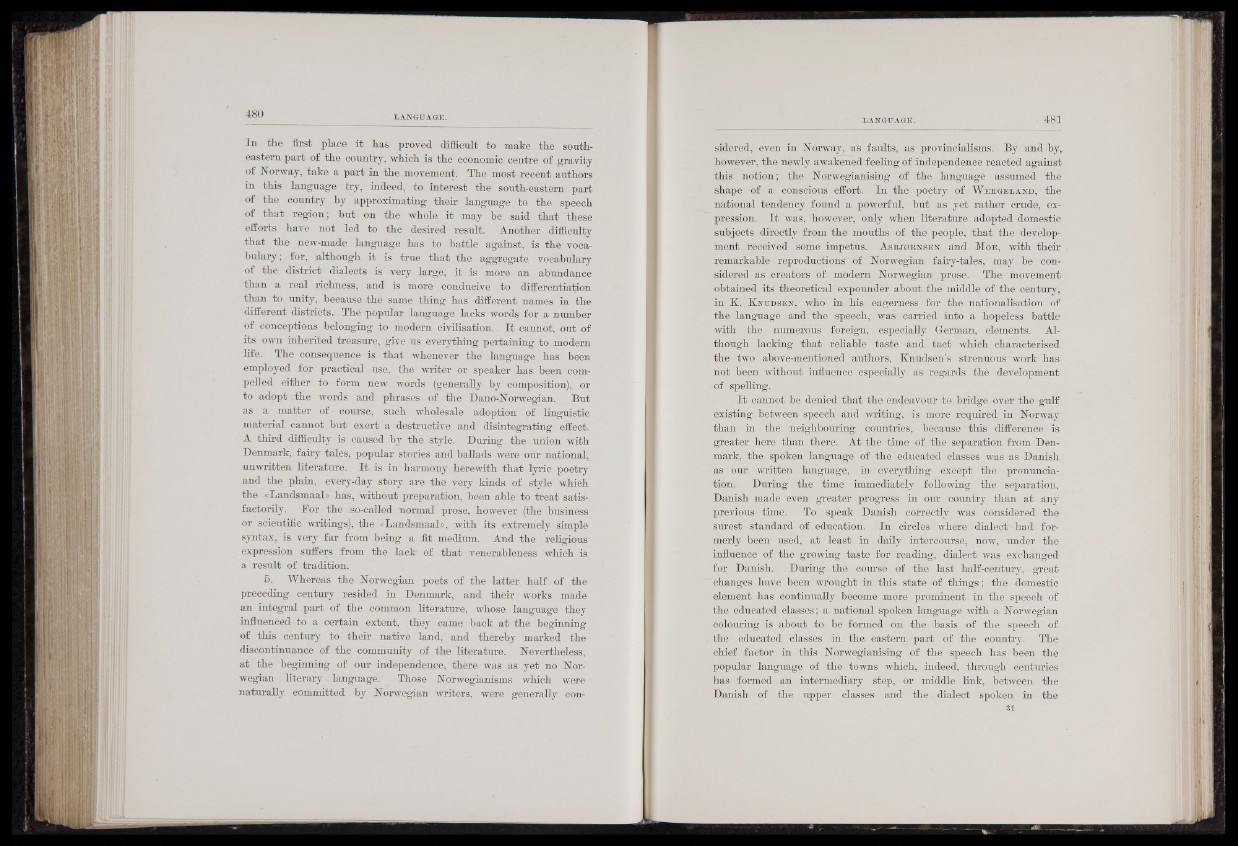
In the first place it has proved difficult to make the southeastern
part of the country, which is the economic centre of gravity
of Norway, take a part in the movement. The most recent authors
in this language try, indeed, to interest the south-eastern part
of the country by approximating their language to the speech
of that region ; but on the whole it may be said that these
efforts have not led to the desired result. Another difficulty
that the new-made language has to battle against, is the vocabulary
; for, although it is true that the aggregate vocabulary
of the district dialects is very large, it is more an abundance
than a real richness, and is more conducive to differentiation
than to unity, because the same thing has different names in the
different districts. The popular language lacks words for a number
of conceptions belonging to modern civilisation. I t cannot, out of
its own inherited treasure, give us everything pertaining to modem
life. The consequence is that whenever the language has been
employed for practical use, the writer or speaker has been compelled
either to form new words (generally by composition), or
to adopt the words and phrases of the D ano-Norwegi an. But
as a matter of - course, such wholesale adoption of linguistic
material cannot but exert a destructive and disintegrating effect.
A third difficulty is caused by the style. During the union with
Denmark, fairy tales, popular stories and ballads were our national,
unwritten literature. I t is in harmony herewith that lyric poetry'
and the plain, every-day story are the very kinds of style which
the «Landsmaal» has, without preparation, been able to treat satis-,
factorily. For the so-called normal prose, however (the business
or scientific writings), the «Landsmaal», with its extremely simple
syntax, is very far from being a fit medium. And the religious
expression suffers from the lack of that venerableness which is
a result of tradition.
5. Whereas the Norwegian poets of the latter half of the
preceding century resided in Denmark, and their works made
an integral part of the common literature, whose language they
influenced to a certain extent, they came back at the beginning
of this century to their native land, and thereby marked the
discontinuance of the community of the literature. Nevertheless,
a t the beginning of our independence, there was as yet no Norwegian
literary language. Those Norwegianisms which were
naturally committed by Norwegian writers, were generally considored,
even in Norway, as faults, as provincialisms. By and by,
however, the newly awakened feeling of independence reacted against
this notion; the Norwegianising of the language assumed the
shape of a conscious effort. In the poetry of W e r g e l a n d , the
national tendency found a powerful, but as yet rather crude, expression.
I t was, however, only when literature adopted domestic
subjects directly from the mouths of the people, that the development
received some impetus. A s b j o r n s e n and M o e , with their
remarkable reproductions' of Norwegian fairy-tales, may be considered
as creators of modem Norwegian prose. The movement
obtained its theoretical expounder about the middle of the century,
in K. K n u d s e n , who in his eagerness for the nationalisation of
the language and the speech, was carried into a hopeless battle
with the numerous foreign, especially German, elements. Although
: lacking that reliable taste and tact which characterised
the two above-mentioned authors, Knudsen’s strenuous work has
not been without influence especially as regards the development
of spelling.
I t cannot be denied that the endeavour to bridge over the gulf
existing between speech and writing, is more required in Norway
than in the neighbouring countries, because this difference is
greater here than there. At the time of the separation from Denmark,
the spoken language of the educated classes was as Danish
as our written language, in everything except the pronunciation.
During the time immediately following the separation,
Danish made even greater progress in our country than at any
previous time. To speak Danish correctly was considered the
surest standard of education. In circles where dialect had formerly
been used, at least in daily intercourse, now, under the
influence of the growing taste for reading, dialect was exchanged
for Danish. During the course of the last half-century, great
changes have been wrought in this state of things ; the domestic
element has continually become more prominent in the speech of
the educated classes; a national spoken language with a Norwegian
colouring is about to be formed on the basis of the speech of
the educated classes in the eastern part of the country. The
chief factor in this .Norwegianising of the speech has been the
popular language of the towns which, indeed, through centuries
has formed an intermediary step, or middle link, between the
Danish of the upper classes and th e . dialect spoken in the
31